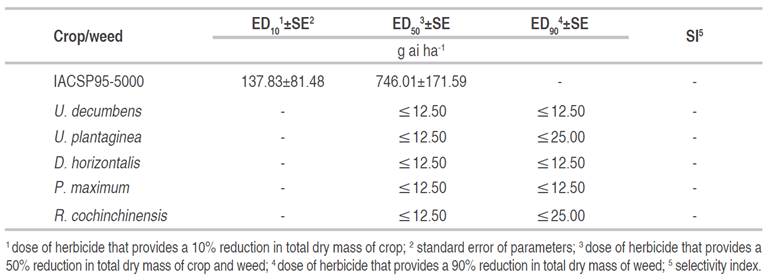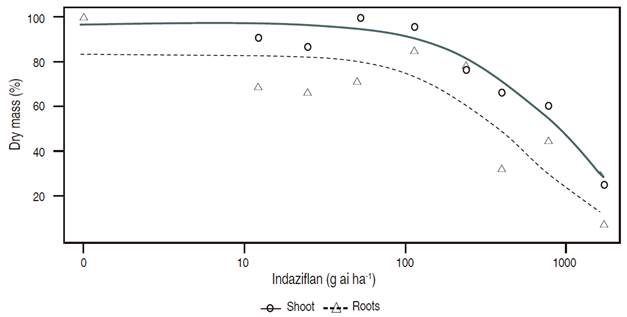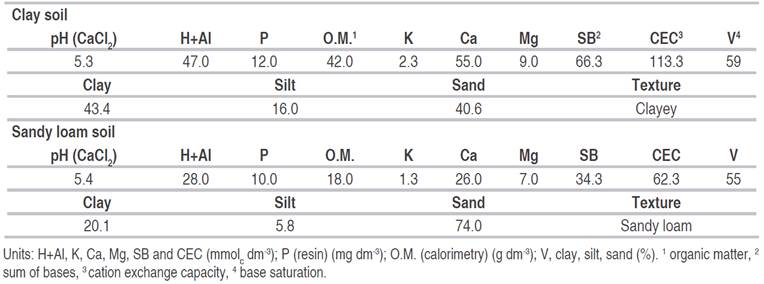In the sugarcane crop, chemical control of weeds is the most used method (Reis et al., 2019), with high use of herbicides, mainly due to the large extension of cultivated areas. For effective chemical control, it is especially important to know the mode of action of the herbicides, the factors involved in the selectivity, and the behavior of the herbicides in the soil (Victoria-Filho and Christoffoleti, 2004).
Herbicide selectivity can be defined as the ability of an herbicide to control weeds without affecting the plants of interest, that is, without reducing crop productivity (Rasmussen et al., 2008). It can occur because of the factors related to the characteristics of plants, such as translocation and differential absorption, age of plants, cultivar, differential metabolism, dimensions of seeds or propagation structures, and factors related to the characteristics of herbicides and their modes of application, such as dose, formulation, and selectivity by position (Oliveira Júnior and Inoue, 2011).
In addition to factors related to plants, the selectivity of herbicides also depends on the type of soil, with the textural class associated with the organic matter content being one of the main factors involved in the dynamics of herbicides in the soil (Silva and Silva, 2007; Inoue et al., 2009). As a result, the physical, chemical, and biological characteristics of the soil directly influence the sorption of the herbicide, affecting the amount of the molecule available in the solution and consequently the selectivity of herbicides applied in pre-emergence (Karpinski et al., 2014).
The weeds that make up the seed bank can also be a factor in determining the selectivity of the herbicide, where plants are difficult to control at higher doses, and this can increase the possibilities of injury in the crop. The evaluation of the toxicity of an herbicide to a specific crop can be carried out by assigning visual notes according to the severity of the injuries, comparing them as treated plants with the control where there is no herbicide application. Nevertheless, in some conditions, reductions in crop yields are observed after herbicide application, even though they do not cause visual injuries (Carvalho et al., 2009). Therefore, when evaluating selectivity, in addition to visual symptoms of intoxication, it is important to consider factors related to yield (Monquero et al., 2011).
According to Ritz and Streibig (2005) in some cases, injury can be accepted with low damage symptoms or a reduction in production if effective weed control is made. For example, a 10% reduction can be tolerated (ED10), while 90% weed control (ED90) can be considered a satisfactory level of control. Thus, other methods can be adopted to evaluate the selectivity of herbicides, such as the selectivity index (SI). This index can be defined as the ratio between the ED10 of the crop and the ED90 of the weed. The higher the SI, the more selective the herbicide will be (Wang et al., 2018).
Indaziflam is an herbicide belonging to the alkylazine chemical class, using in pre-emergence of liliopsidas and magnoliopsidas weeds (Brosnan et al., 2012). This molecule presents mainly selectivity to semi-perennial and perennial crops, having low selective for annual crops (Guerra et al., 2013).
For this reason, this study aimed to determine the selectivity of the herbicide indaziflam, calculating the selectivity index for the sugarcane crop (IACSP95-5000 cv.), in the analysis of five species of weed in two textures of soil.
MATERIALS AND METHODS
Experimental design and conditions
The experiment was performed in a greenhouse in the city of Piracicaba, São Paulo, Brazil (22°42'31.09" S, 47°37'41.81" W), without temperature control, under natural condition, with an irrigation of 5 mm day-1, between January 21 to March 19, 2019. Sandy loam and clay soil were used (Table 1), placing in 5 L plastic pots for planting sugarcane and sowing weeds. The soil was collected from an experimental area located in Piracicaba, in places with low weed infestation.
Five weed species, important in the cultivation of sugarcane, were used: Urochloa decumbens (Stapf) R.D. Webster, Urochloa plantaginea (Link) R.D. Webster, Digitaria horizontalis Willd., Panicum maximum Jacq. Rottboellia cochinchinensis Lour. Clayton. Plants of other species, which came to emerge in the pots, were removed manually. The sugarcane cultivar IACSP95-5000 (SP84-2066 x SP80-185) was used, which is adapted to most growing regions in the Center-South region of Brazil.
Weed species were sown on January 22, 2019. Sugarcane was planted using three wheels per pot, with a viable yolk per wheel and a planting depth of 0.08 m. 100 seeds per pot were used for each weed species, covered with a soil layer of approximately 0.02 m. Prior to the sowing of weeds, a germination test was performed, with 38% emergence for U. decumbens, 16% for U. plantaginea, 36% for D. horizontalis, 56% for P. maximum and 18% for R. cochinchinensis.
The treatments consisted of the application of doses of indaziflam (Allion®, Bayer CropScience Ind. Ltda, Brazil), in the five species of weeds. Doses 0, 0.125, 0.25, 0.50, 1, 2, 4, 8 and 16X were used at a dose of 100 g ai ha-1, equivalent to 0; 12.5; 25; 50; 100; 200; 400; 800 and 1,600 g ai ha-1 of the herbicide. A completely randomized design with four replications was used, where each pot was comprised of an experimental unit.
The application of indaziflam occurred in total pre-emergence of weeds and sugarcane one day after sowing and planting. At the time of application, the loamy and sandy soils had a humidity of 14.73 and 23.36%, respectively. For the application, a CO2 sprayer pressurized with 1 bar equipped with four spray nozzles (XR 11002, TeeJet® Technologies South America, Brazil) was used. With a pressure of 2 bar, 50 cm height from the surface of the pots, and at 1 m s-1 speed, reaching an applied range of 50 cm wide per spray nozzle, and a spray volume of 200 L ha-1.
Evaluations and data collection
The assessment of dry mass of the shoot and root was performed at 60 days after application (DAA). To generate the selectivity index, sugarcane plants and weed species were collected, being cut close to the ground and packed in paper bags, and the root system was separated and washed under running-water until complete cleaning and later conditioned in paper bags. The samples were dried in an oven with forced air circulation at 65 °C for 72 h and measured on a scale to two decimal places.
Data analysis
The results were subjected to analysis of variance (ANOVA) to verify the effect of doses of indaziflam (P<0.05). The non-linear logistic regression model was adjusted using the DRC package in the R software (Streibig, 1988; Ritz et al., 2015), as shown in Equation 1.
Where:
Y=Total dry mass; α=maximum value; x=indaziflam dose in g ai ha-1; b= resulting dose at 10, 50 and 90% reduction in total dry mass (ED10, ED50 e ED90); c=curve slope.
The SI calculation for sugarcane as a function of weed species was obtained by Equation 2 and took into account the herbicide dose necessary for a reduction of 10% in the total dry mass of sugarcane and 90% in the total dry mass of weed species, these doses were obtained by the equation:
Where: SI=selectivity index; ED10=dose of herbicide that resulting in a 10% reduction in the total dry mass of sugarcane; ED90=dose of herbicide that resulting in a 90% reduction in the total dry mass of the weed.
RESULTS AND DISCUSSION
In sandy loam soil, as weeds were susceptible to indaziflam, 0.25 of the recommended dose (25 g ai ha-1) has already provided 100% control. As a result, the weed dry mass data did not fit the log-logistic model of three-parameter suggested to estimate the selectivity index. However, U. decumbens species, D. horizontalis and P. maximum were the most controlled weeds by the herbicide in this soil, where at the dose of 12.5 g ai ha-1 showed reductions in the dry mass of 90% (Table 2).
Table 2 Selectivity index (SI) and effective dose (ED) of the herbicide indaziflam that cause reductions in dry mass by 10% and 50% for sugarcane and reductions of 50% and 90% in weed species in a sandy-loam soil texture.

Sugarcane IACSP95-5000 in soil with a sandy loam texture showed a 10% reduction in dry mass (ED10) at a dose of 137.83±81.48 g ai ha-1 and a 50% reduction in dry mass (ED50) at a dose of 746.01±171.59 g ai ha-1 (Table 2). In the clay soil, a higher ED10 was exhibited using 353.23±109.37 g ai ha-1 and ED50 at 671.07±80.62 g ai ha-1 (Table 3). Thus, the percentage of reduction in total dry matter (ED10) of this cultivar in soil with a sandy loam texture occurred with a lower dose of the herbicide (Figure 1).
Table 3 Selectivity index (SI) and effective dose (ED) of the herbicide indaziflam that cause reductions in dry mass by 10% and 50% for the cultivar of sugarcane and reductions of 50% and 90% in weed species in clayey soil.


Figure 1 Total dry mass reduction (%) of sugarcane cultivar IACSP95-5000 under indaziflam doses in different soils textures.
In clay soil, the species most susceptible to indaziflam was D. horizontalis, where 90% of the species control (ED90) was obtained at a dose of 25 g ai ha-1, with no adjustment possible (Figure 2). The R. cochinchinensis was the species less controlled by the herbicide, followed by the species U. plantaginea, P. maximum, and U. decumbens, where the 90% reduction in total dry mass was obtained at doses of 193±50; 152±50; 124±150 and 94±30 g ai ha-1, respectively. The selectivity index was higher due to the species U. decumbens being 3.76, followed by the species P. maximum with 2.84, U. plantaginea with 2.32 and R. cochinchinensis with 1.83 (Table 3).
In sandy loam soil, sugarcane root system was the most affected with lower doses of the herbicide indaziflam when compared to its shoot system (Figure 3). The ED10 for the root system was obtained with the dose of 95.15±89.59 g ai ha-1 and for the shoot it was 162.61±112.12 g ai ha-1 (Table 4). The doses of the herbicide for ED50 in this same soil were also higher for shoots 938.19±239.04 g ai ha-1 and for the root system it was 530.40±147.77 g ai ha-1.

Figure 3 Dry mass reduction (%) from shoot and roots of IACSP95 - 5000 sugarcane cultivar under indaziflam doses on sandy loam soil.
Table 4 Indaziflam doses that cause dry mass reductions in dry mass by 10% and 50% of the IACSP95-5000 cultivar depending on the plant part and soil texture.

In the clay soil, the root system was more affected with lower doses of the herbicide when compared to the shoot (Figure 4). The ED10 was obtained in the doses of 306.93±97.72 g ai ha-1 for the root and 361.22±111.81 g ai ha-1 for the shoot. However, the doses required for ED50 in the root system were higher for this soil, being 837.51±111.49 g ai ha-1 for the root and 770.09±71.07 g ai ha-1 for the shoot (Table 4).

Figure 4 Dry mass reduction of aerial from shoot and roots of IACSP95-5000 sugarcane cultivar under indaziflam doses on clay soil.
The application of indaziflam (0, 30, 60, 90, 120 and 150 g ai ha-1) in pre-emergence of P. maximum, D. horizontalis, and R. cochinchinensis, in three soils with different physical and chemical characteristics, was effective in controlling species. P. maximum and D. horizontalis were controlled from the dose of 30 g ai ha-1, regardless of the type of soil (Amim et al., 2014). The present study corroborates these results, where D. horizontalis species was very susceptible to indaziflam regardless of the type of soil, with all species controlled in the lowest doses. However, in clay soil species such as P. maximum and R. cochinchinensis showed a 90% reduction in total dry mass at doses of 124.39±52.77 and 193.02±48.46 g ai ha-1 respectively; these doses are higher than those recommended for the herbicide for similar soils (Rodrigues and Almeida, 2018).
Indaziflam was selective for the IACSP95-5000 sugarcane cultivar. In the sandy loam soil, the ED10 was lower than the dose required for the same reduction in clay soil. This may have occurred given that indaziflam has a positive correlation to organic matter, due to its high value of the sorption coefficient normalized by organic carbon (Koc<1,000 mg g-1) and a high value of the octanol-water partition coefficient (Kow=2.8), contributing to greater sorption of organic matter and consequently lower availability in the soil solution, impacting on selectivity and weed control (Tompkins, 2010; Alonso et al., 2011; Sebastian et al., 2017).
These factors may have had an impact on the selectivity and control of the weed species evaluated in this study, since the sandy loam soil has a lower organic matter content (18 mg dm-3) than the clay soil (42 mg dm-3) and consequently, to reach ED10, a lower dose of the herbicide was necessary. Also, in sandy loam soil, indaziflam was effective in controlling weed species with lower doses. Sebastian et al., (2017) evaluated the influence of the physical-chemical properties of the soil on the efficacy of controlling indaziflam on Kochia scoparia, and observed that a concentration of 10 to 100 times greater is necessary to promote a 50% growth reduction (ED50) for soil with 16.8% organic matter compared to soil with 0.4%.
Indaziflam application (300 g ai ha-1) did not cause injury to the sugarcane (RB867515 cultivar), in an area with sandy soil (Simões, 2018). However, from the dose of 137.83±81.48 g ai ha-1, reductions of 10% in the total dry mass was observed. In the present study, the selectivity index was not possible to obtain for the sandy loam soil, due to the sensitivity of the species to the herbicide indaziflam in this type of soil. This can be correlated with the physical-chemical characteristics of the soil, being the herbicide more available. It may be considered that indaziflam was very selective in this type of soil, due to the control of the weed species evaluated in the first doses and because it required relatively high doses to cause reductions in the dry mass of the sugarcane cultivar. In clay soil, indaziflam was also considered selective, even with the need for higher doses to control species. A selectivity index value greater than 1 indicates that the herbicide is more selective due to the weed species (Bartley, 1993).
A reduction in dry root mass was observed in the sandy loam soil with lower doses of indaziflam (95.15±89.59 g ai ha-1), when compared to the shoot in this same soil (162.61±112, 12 g ai ha-1). In clay soil, the doses of indaziflam required for a 10% reduction in root dry matter were 306.93±97.72 g ai ha-1. The reduction in biomass and morphology of the root system by indaziflam has also been observed in other studies (Jones et al., 2013; Brabham et al., 2014; Jones et al., 2015; Schneider et al., 2015).
Schneider et al. (2015) obtained similar results to the present study, using Cynodon dactylon plants, in the sand, regardless of the indaziflam dose, an injury was observed, with a root and shoot reduction of 32 and 10% up to 10 cm depth, respectively. This may be a factor that influenced the results of this study, as the sugarcane stems were planted at 8 cm depth, where the first roots may have come into contact with the herbicide. The authors also observed that the increase in clay content and especially the addition of organic matter, significantly improved the root mass at a dose of 16 g ai ha-1 compared to sandy soil without organic matter. However, this same dose caused inhibition in the growth of the roots, without influence on the development of the shoot of the plant in the sandy and clay soils even with organic matter.
The physico-chemical properties of indaziflam suggest that the molecule can be moderately mobile in the soil (solubility in water (Sw)=4.4 mg L-1 at pH 4.0) due to the long persistence (half-life time (T1/2)>150 days) associated with low solubility in water (Sw=2.2 mg L-1 at pH 7.0 to 9.0) and moderate sorption (sorption coefficient (Kd)=4.9 to 27.4 g mL-1) (Tompkins, 2010; Alonso et al., 2011). Nevertheless, as the sandy loam soil has a lower content of organic matter (18 mg dm-3) compared to the clay one (42 mg dm-3), and the herbicide has a great affinity to organic matter (Koc<1,000 mg g-1 ), and with the presence of water during the entire conduction of the experiment, indaziflam may have had more mobility in the sandy loam soil, causing greater reductions in the root system of sugarcane in this soil.
CONCLUSIONS
In sandy loam soil, the indaziflam dose of 25 g ai ha-1 provided 100% control for all weeds. In clay soil, for D. horizontalis the ED90 was obtained at 25 g ai ha-1, for R. cochinchinensis at 193 g ai ha-1, for U. plantaginea at 152 g ai ha-1, for P. maximum at 124 g ai ha-1, and for U. decumbens at 94 g ai ha-1. Indaziflam was selective to IACSP95-5000 sugarcane cultivar in both soils, with ED10 at 137 g ai ha-1 for soil with a sandy loam texture and 353 g ai ha-1 for clay soil. The selectivity index was higher than 1 for all weeds in clay soil. It was not possible to obtain the selectivity index for sandy loam soil due to species susceptibility to the herbicide.


















